Art World
Kenny Schachter’s Dealer’s Diary: Shanghai’s West Bund Art Fair and ART021
Inexplicably, Adrian Brody had a booth of his very own.
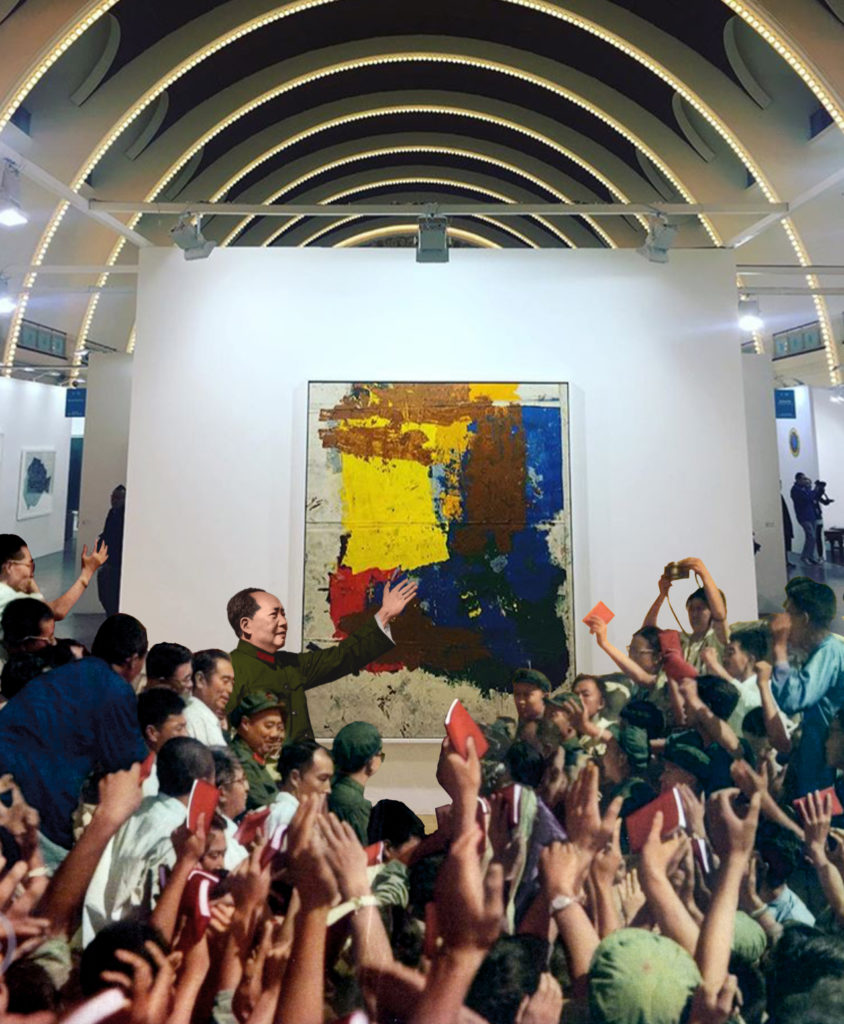
Inexplicably, Adrian Brody had a booth of his very own.

Kenny Schachter

This may be the craziest, most pathetic thing I’ve written but consider this an appeal to action—or inaction—in light of recent political events, the relevance and significance of art has just been elevated a few notches. Art and empathy are about all we have left to join together with a view to dissolving walls, prejudices, rhetoric and worse: let us transcend Trump, one painting, museum, gallery, biennial and art fair at a time. What choice have we?
By the way, with the notion that Monopoly money may exceed the value of the US currency in the short-to-intermediate term, a call to art is probably the soundest investment advice afoot (viz. the New York auctions next week will go nuts).
Shanghai, where I was for the past five days catching two fairs, a load of artist studios, private museums and galleries is also home to a welcoming lack of cynicism (in the art world at least). It boasts the only art fairs in mainland China and besides, is more hospitable and navigable than Beijing or Hong Kong.
There is ART021 SHANGHAI, in its 4th iteration, and West Bund Art & Design fair in its 3rd. SH Contemporary, owned by the Bologna art fair (don’t ask) that started way back in 2007, an eternity ago in China for such fare, was cancelled because of censorship and customs issues.
There is a Chinese wall preventing full access to the Internet in China even at the big international hotels, which is circumvented by downloading VPN (virtual private network) apps, which software lasts periodically until shutdown by the government.
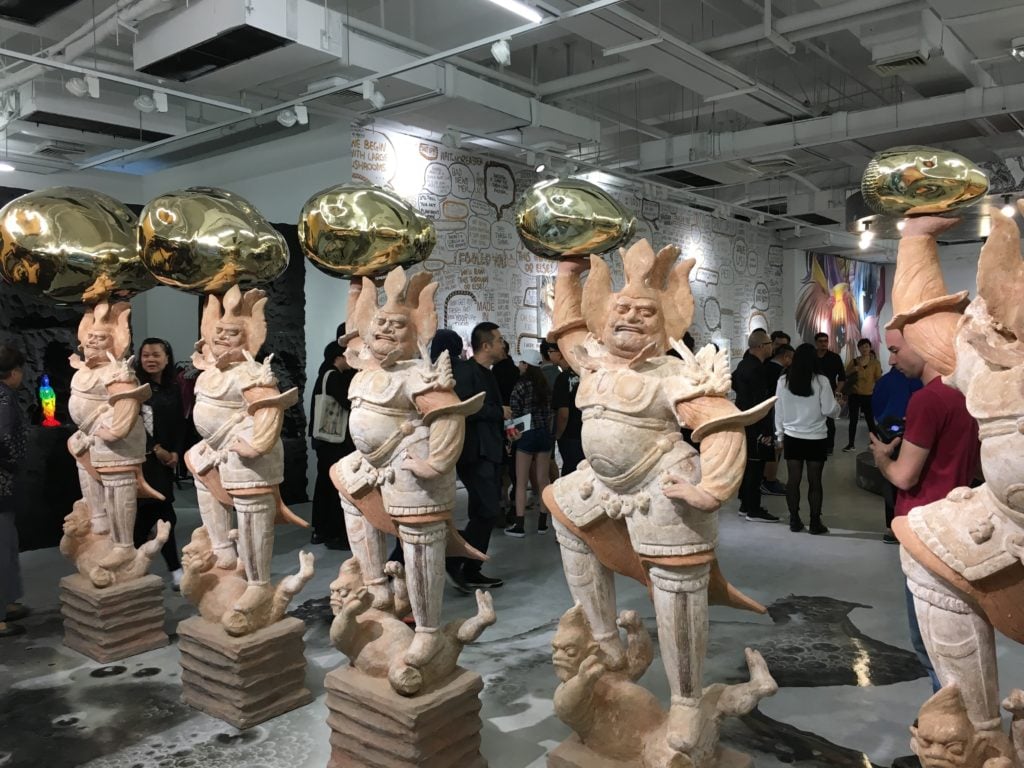
The Madein shop by Xu Zhen. Courtesy Kenny Schachter.
I could only use my laptop via the VPN on my iPhone connection, further enslaving me to the device—Steve Jobs’s wet dream. Luckily for me, there was full access to the Daily Mail, the paper everyone in the UK reads (but no one admits to), but not the New York Times.
WeChat, a sweeping social media platform where you can play and pay (through a digital wallet) and just about everything else, is China’s answer to Facebook, Instagram, WhatsApp, Google, etc. (all verboten). A new tool to communicate with, I’m still using it; I was gleefully scanning QR (Quick Response) codes like a child, you will have to ask one to have it explained fully.
I suggest you download it providing instant access to China’s entire art world. That WeChat is not owned by Mark Zuckerberg yet (Tencent is the stock listed holding company) is reason enough. And forget Uber, it was taken over by the Chinese and is no longer available—unless you have a local credit card (or the digital equivalent), or still possess an older version of the app, for some reason. Where is Kafka when you need him?
The purpose of my trip was as much reconnaissance and meeting people as seeing art; particularly, I wanted to get an impression of the depth of interest in recent international contemporary art and gauge the market, it was all beyond expectations.
In sympathy for the near-impossible-for-me-to-pronounce Chinese names—they have a thing for Xs and Zs—many adopt Westernized versions and boy, did I need all the help I could get.
I want to reciprocate and assume a Chinese name as I find they have the same difficulties. I identified with the screaming taxi drivers, especially the adventurous daredevil that played an impressive game of chicken with a garbage truck—I half laughed and cried (in fear).

Neil Beloufa at the K11 Art Foundation. Courtesy Kenny Schachter.
I kicked off at Budi Tek’s Yuz Museum where he staged “Overpop,” a show co-organized by Jeffrey Deitch and Karen Smith, a British curator long residing in Shanghai.
The show was initially conceived by Jeffrey but Karen was a late-in-the-game add-on; seemingly Jeffrey got diluted midstream to keep things more balanced (and probably down-to-earth cost-wise). The lively show was a commixture of recent young stars (basta!) like Math Bass, Helen Marten, Camille Henrot with Chinese practitioners like Aaajiao, the virtual persona of talented Shanghai-based artist Xu Wenkai. If anything is clear, we are data determined to death.
I bumped into Budi sitting with a friend in the cafeteria where he implored me to be critical (about the institutions and China), but nice.
At a gala dinner for the museum later in the week Tek gave an affecting speech about the future of private museums, which he stated was never a certainty and less so in China, additionally mentioning that he was suffering from an illness that was touching and somehow optimistic.
In any event, as Tek sympathetically put it, art outlasts us all. There was the “She” show at the Long Museum down the block, founded by Liu Yiqian and his wife Wang Wei, an inconsistent smattering of international woman artists laudable for the gesture and a fun window into Yiqian and Wei’s recent auction acquisitions (and they are plentiful).
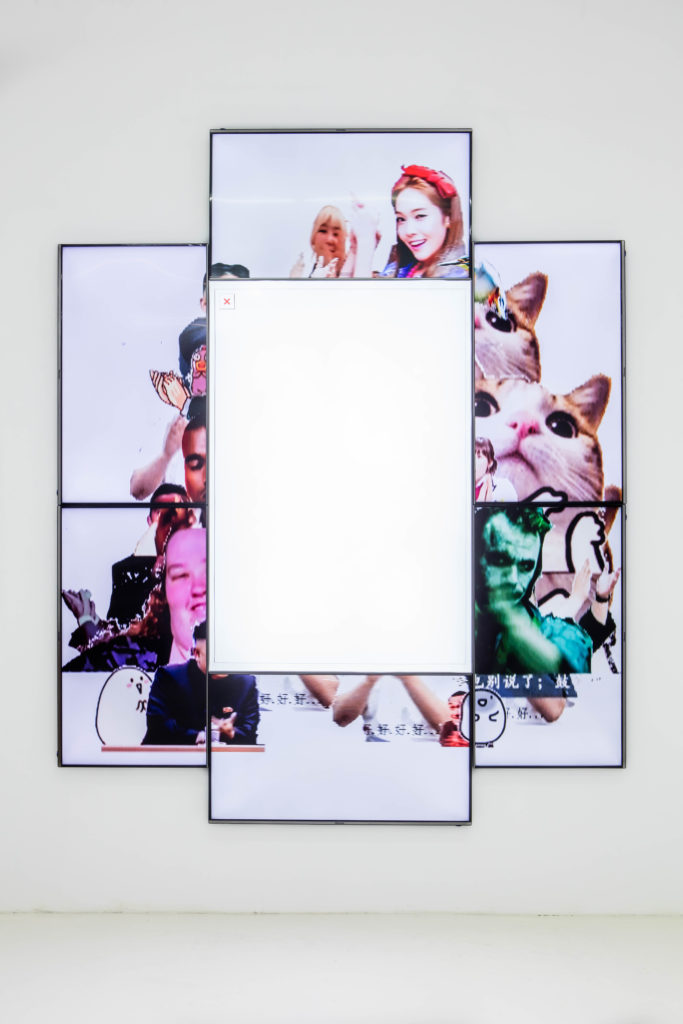
Miao Ying. Courtesy Kenny Schachter.
Xu Zhen (pronounced Zoo Chen), an artist and entrepreneur born in 1977, formed Madein Company in 2009—as in made in China (which evaded me at first blush, I admit) and a play on the Chinese word for no roof or limits—and the brand “Xu Zhen produced by Madein Company” launched in 2013, are you following me?
To simplify, Xu operates a retail shop featuring fashion, furniture and art (his own and others) an art gallery, partaking in the ART021 fair, and a production studio chock full of 50-60 toiling assistants (considering the labor market, that’s mild); he’s Shanghai’s flyover from Andy and Keith to Damien and Jeff.
Zhen’s auction record at over $500,000 was set at Poly in China in 2013 for a 2013 work (Xu, that had to be you consigning!) from a series where he photographed famous paintings with a flashbulb then had them meticulously remade with the glaring reflection distorting the image.
Of his many strands of production are cutesy clumps of colorful paint squirts, like cake frosting, which you could even schedule to make with him (a lesson from Hirst’s participatory spin machine, no doubt).
His most successful works were gigantic sculptures that collide (literally) Eastern and Western classical sculptural forms meticulously and laboriously hand crafted in the studio; not so much at odds as in a violent but incidental merger.
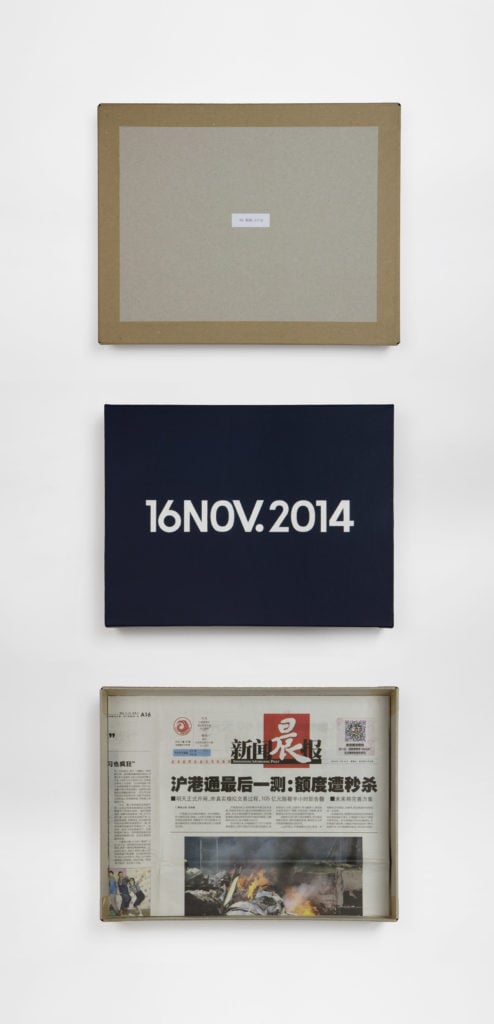
Lu Pingyuan from Madein gallery. Courtesy Kenny Schachter.
I spent a marathon day doing rapid fire studio visits (including Xu’s) which felt like a replay of my 1990s life showcasing the works of emerging, unaffiliated artists. The tour was organized by a London friend, Yi Luo (Lori), who I met through Instagram after she informed me of a snide, anonymously written article published on WeChat about my writings; with the tenor of my columns, how could I be anything but amused?
It turns out, she probably wrote it too—even better. A collector from Hangzhou, also on the tour, happened to own a work by Vito Acconci (my hero); she told me she was a fan of my writings, despite their length (a frequent gripe, sorry!), which she read in English “to help learn superfluous words.” China was really beginning to resonate.
The Westbund Art and Design Fair is held in the former Shanghai Aircraft Manufacturing Factory, since transformed into an art center. The government-supported fair is directed by Zhou Tiehai, a painter and former director of the Minsheng Art Museum. Apparently he wasn’t amused when I referred to him in a prior piece as the Joe Camel painter, which made him quite renowned and well-off—his auction record set in 2014 at Sotheby’s in Hong Kong stands at about $615,000—but he and his partner, Gan Weiwei (aka Vivienne), no relation to Ai, were exceptionally gracious and hospitable. She kindly, personally accompanied me to highlight certain Chinese venues, introducing me as “famous but sharp” (Artnet articles are translated into Chinese).
As most criticism in China is either too positive or biased (they get paid to shill, I was told), they appreciate an impartial voice. And like me, they like to snipe as much as anyone, if not more so.
Tiehai’s gruff personality adds a much-needed artist’s touch to such overtly commercial enterprises, and in this vein, he facilitates subsidies for artist-run spaces and those less financially able participants. Mixed with Zwirner and Hauser & Wirth, it was a generous idea.
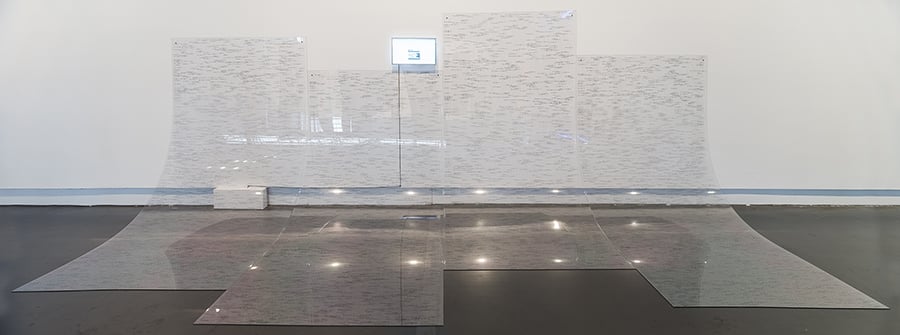
aaajiao, the virtual persona of Shanghai-based artist Xu Wenkai from the Yuz museum. Courtesy Kenny Schachter.
A few asides: there wasn’t a familiar face at Pace, they must have all been in Silicon Valley chasing Facebook friends. A few international galleries like Timothy Taylor and Zwirner had labels only in Chinese.
When I asked Ben Brown about his Lucio Fontana he revealed it was, for some incomprehensible reason, a work by Gavin Turk. Brown said, “Why would I bring a $20 million painting when I could sell it easier in Europe or Hong Kong, another planet than China.” You just wait is my feeling. Where was Ivan Wirth of Hauser, present in both fairs but missing in action? The only downside I could see was Starbucks as the food court anchor.
Sadie Coles had a covetous pair of (cement) boots by Sarah Lucas at £180,000 and works by John Currin and Urs Fischer. At Zwirner there was a translucent Sigmar Polke at $1.8 million, which I was admonished not to broadcast worldwide so keep it between us.
Massimo De Carlo’s Rudolf Stingel was presold at about $1.5 million, as they always seem to be nowadays. There were also two new colorful suicide paintings by Rob Pruitt at $70,000 each (happy suicide paintings?).
New York painter Austin Lee was on hand for $26,500 at Bank Gallery from Shanghai run by New Yorker Mathieu Borysevicz (showing in the gallery as well). White Cube sold a Theaster Gates for $325,000 to a young Chinese collector, Lu Xun, of the formidable Sifang Art Museum in Nanjing designed by Steven Holl.
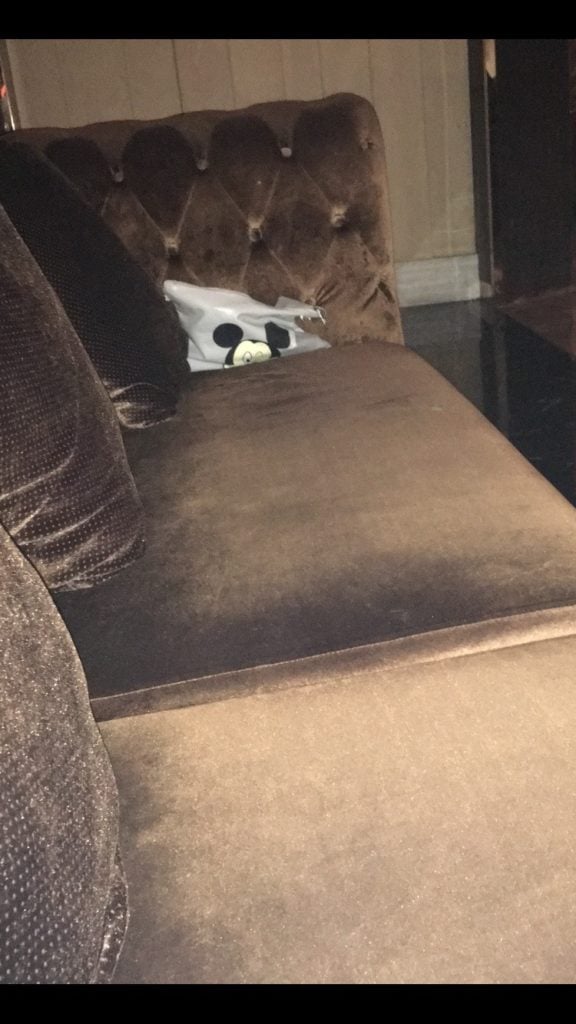
Brown couch at karaoke bar. Courtesy Kenny Schachter.
Foundations are popping up like rashes all over town showcasing private collections but housed in publicly subsidized buildings. Private developer and art patron Adrian Cheng’s K11 Art Foundation put on a sprawling exhibit of Neil Beloufa and Guan Xiao; though I wasn’t bonkers for Beloufa, the ambitious installations and videos of Xiao, recently on view in London’s ICA was a standout. Her works are also at ART021 with Antenna Space, a trendy up-and-comer, funded by one of the fair founders. Interconnectedness abounds. During the dinner celebrating the fair, the elongated tables were surrounded by caterers serving in a vaguely unsettling military formation.
When the collector and proprietor of the upcoming Shanghai Star Museum, He Juxing, gave a speech, my neighbor nudged me and related that He was one of the biggest consignors at the auction house she used to work for.
Afterwards there was a “Serious Adult Dance Party” hosted by collector Linyao Kiki Liu and none other than Klaus Biesenbach. In what other field can you find a dingy basement of revelers late into the night consisting of all corporate tiers of a market; from collectors, gallery owners (David Zwirner, Emmanuel Perrotin and Sadie Coles), artists and auction execs to gallery workers and art handlers, they were all on hand drinking and dancing. And Hans Ulrich Obrist too, of course. Come to think of it, it was positively socialistic. I’m blessed.
I returned to my hotel where they were hanging cartoonishly scaled Christmas decorations rivaling Rockefeller Center, that’s China for you.
The following day I went on a gallery tour with Luluc Huang, Chinese representative of the Basel VIP team and husband Philip Tinari, writing a PhD at Oxford and the director of the Ullens Center for Contemporary Art in Beijing, about to be privately sold under sealed bid.
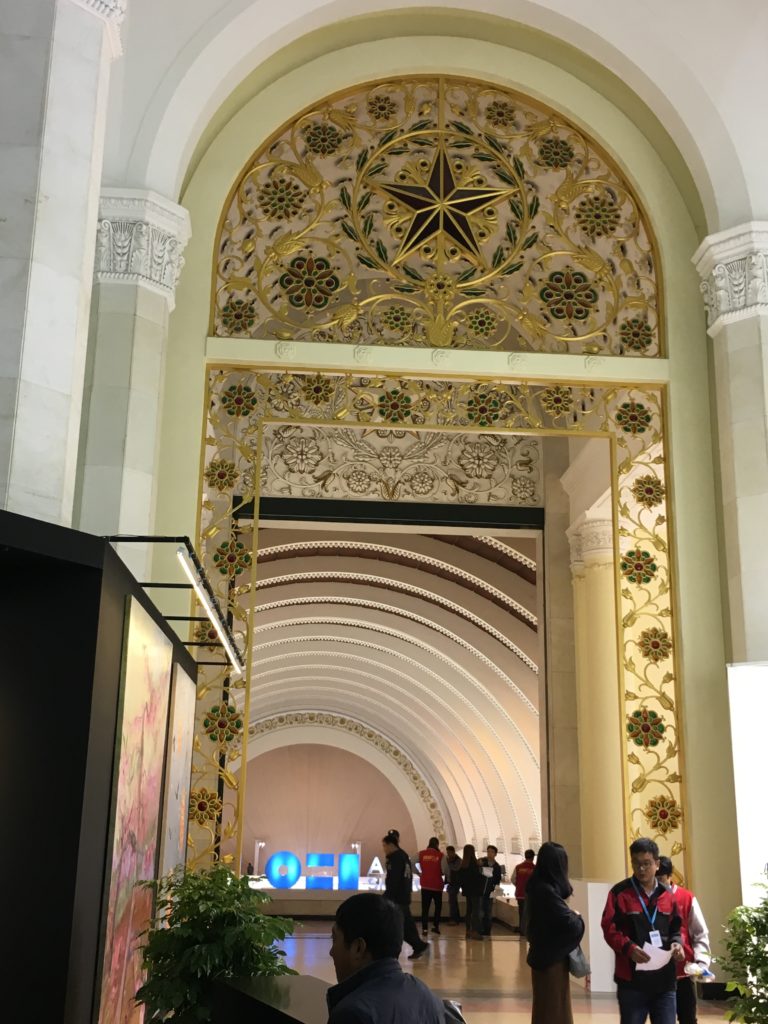
Art021 venue. Courtesy Kenny Schachter.
Tinari was beside himself, not because of the upheaval at the Ullens; he’s American and a sensitive, intellectual one at that (sporting some pretty cool green velvet shoes) as we watched the elections slip away from Hillary on our VPN enabled phones. A friend chimed in, “What a terrible time to be white.”
There was every stripe of gallery ranging from the first, ShangART established in 1996 by Swiss born Lorenz Helbling, to Li Zhang’s Shanghai Gallery of Art, a commercial space with institutional airs and the small but charming conceptual Don Gallery run by Xixing Cheng.
The private fair ART021 was started by David Chau (Zhou Dawei) in the fleet management business, Kelly Ying (married to Chau) and Bao Yifeng, both in public relations, and all young. Because I was departing prior to the onset of the fair (and the Shanghai Biennale, less of a draw) held in the ornate Shanghai convention center gifted by the Soviets to China in 1954, the owners let me in early. Eat it Marc Spiegler.
The fair, though international in scope, had a very Chinese essence; it was a vibrant, lively endeavor and comprised of 84 galleries, nearly three times the size of West Bund. The owners are successful, hip and cheerful, one of whom also owns a football team with jerseys designed by Ryan Gander.
There were fancy corporate sponsors like Porsche (is there a single Porsche in China?) and champagnes and the requisite VIP lounge. I wasn’t allowed to take pictures but was trailed by an ART021 photographer.
The Faberge egg-like building was perfectly pitched to the array of galleries, mostly Asian with a smattering of megas like Larry G. There were a large number of dealers doing both, like going to and fro from miniature versions of Frieze and Frieze Masters, including Zwirner, Hauser and many Chinese galleries as well. You wonder if the city will be able to sustain both, but I hope they manage.
Just like at West Bund, the vibe of it all made the hair stand up on my arms; sorry, it’s a new era for chills rather than thrills (and spills). Highflier Oscar Murillo must be a Chinese delicacy; he was the only market darling with works on view at both Zwirners.
Inexplicably, Adrian Brody had a booth of his very own in which he paired his crude fish paintings alongside small scaled black-and-white photos by his mother. I won’t say I’d have preferred the photos by his mother rather than the manqué (but I would have); the booth would be better served as a standalone by the mom. Maybe that explains the omnipresent hospital masks worn by many during the fair set-up.
Made in Gallery showed Lu Pingyuan, who awoke one morning after a dream in which he was compelled to paint On Kawara’s date works in the face of his death, which he now does for $3,000-a-day.
His main series of works consist of short stories about the art world hung like drawings including one about conjoined twins that go on to make art together before having a falling out and getting surgically separated: positively Chapman Brothers-eque. Miao Ying who writes about how we self-censor ourselves by editing our personal photographs, made a photo collage from GIFs from WeChat which depict animals and people clapping. The artist states, “GIFs of leaders clapping their hands are used to commend someone for doing something right. From a Western perspective, this sort of GIF would imply sarcasm, but in China, it’s seen as a genuine compliment.” Her collage consisting of a flatscreen TV, and light boxes was in an edition of three priced at $10,400 (exclusive of equipment).
The party at Shanghai Night, a hybrid karaoke bar/night club/exhibition space/brothel is, you might say, unlike anything else. It is owned by collector Qiao Zhibing, said to be Hauser’s first client in Asia, and about to open a museum of his own.
I am beginning to want one as well. Art is everywhere, throughout, enshrined behind protective glass enclosures. The protocol is to go with a group of friends into a private room, there is floor after floor of them, and be followed in by a line of girls wearing numbers affixed to their dresses—the last supper of hookers. On non-art nights some are said to be clad in wedding dresses for effect.
I heard there are two shifts of 400 girls over the course of a day. You are meant to sing with your girl, while she’s rubbing your crotch, perhaps a tad disconcerting. Sex and singing, maybe I’m unimaginative but I’d have never coupled the two.
But after every blow job, he’s one step closer to a Mike Kelley. There should be a Harvard case study on merging business and pleasure, call it: Wow and How. I was told the actual act doesn’t happen on the premises, only the hookup; and then you retreat to neutral settings, like a takeaway shop—or am I just naïve?
Ensconced in the karaoke room I was the only one in our group solo on the brown velvet couch other than the Mickey Mouse bag of one of the girls. I couldn’t get attention in a whorehouse! I returned to my hotel at 3am in a catatonic state of deep REM sleep dribbling in the back of a taxi. All I remembered was the smell of the room, once a prude…
My trip to Shanghai was characterized by a generosity and purity of spirt I haven’t felt for decades, since my early curatorial efforts. I discovered an art world parallel universe where we are now rubbing up against each other like dogs in a park. The city and people were enchanting—it’s expansive and cosmopolitan but not too much so. I saw so much art I thought my eyeballs were going to explode. Though there wasn’t really anything I wanted to buy, I wholeheartedly buy into the idea of the seriousness and intent of the region to impact art and the market for a long time to come.
What would Mao make of it? With the troubling, scary realities of the world I think I should move to China. Or New Zealand—is there an art fair there? We could use a global dose of some Lech Walesa type solidarity, with art as our solace. I dare say this day of reckoning is good for the art business. After I checked in to the airport, I asked after my gate at the information desk and the attendant replied whether I wanted a massage. Seemed a bit bizarre after no one would sit next to me in a whorehouse.
One last thing, Adrian Brody should watch his back, Robert Redford just announced he’s retiring from acting and will pursue his painting career.